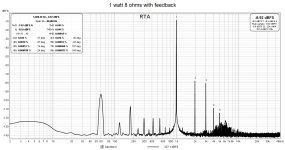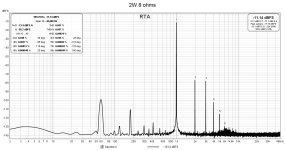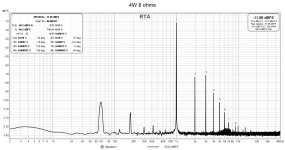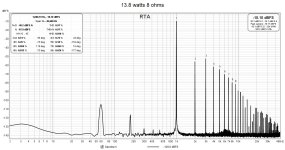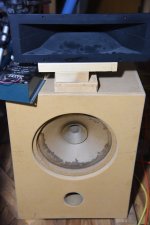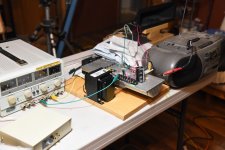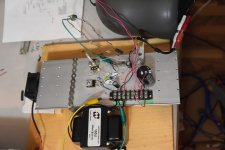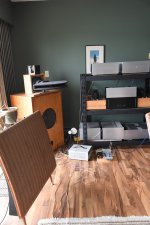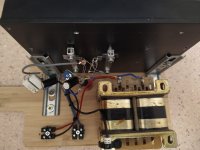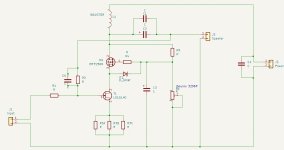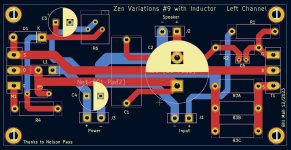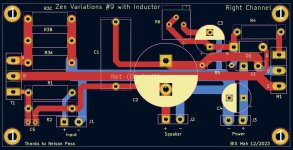Many thanks Bill for the LU model
One problem i have with Spice is that sometimes i do not follow a path because the results of the simulation are too bad, like in the above sample. Spice is very helpful for me, but the "proof is in da Pudding".
Please let us know your listening experience
One problem i have with Spice is that sometimes i do not follow a path because the results of the simulation are too bad, like in the above sample. Spice is very helpful for me, but the "proof is in da Pudding".
Please let us know your listening experience
I made some distortion measurements at various power levels. Power out into 8 ohms reached 13.8 watts before hitting 1% THD. Feedback drops the distortion considerably.
Attachments
If the proof of the pudding is in the eating, then the proof of the amplifier must be in the listening. So, yesterday I hooked the amp to my boom box and test speaker to play something other than 1 kHz tones.
The system is not "hi-fi" but it's good enough for me to tell if the amp is "bad". Of course, even before it gets to this stage, the measurements tell a good story.
After listening to various CDs over the course of an hour and a half, I've decided that the amp is a keeper. It does nothing wrong and it sounds pretty good in some areas. It is smooth sounding without too much sweetness and sounds dynamic. Of course, the Altec compression driver and horn helps the dynamics a lot. I'm in the camp of liking a "live sound" presentation rather than "imaging", so this amp works in that respect.
My test speaker system is fairly efficient, so the amp doesn't have to work very hard. From my measurements, the distortion is fairly low at 1 watt and it is mainly a combination of the second and third harmonic. I've read that the third harmonic can contribute to the dynamic sound.
The bottom line is, if this amp is pudding, I will be eating more of it.
The system is not "hi-fi" but it's good enough for me to tell if the amp is "bad". Of course, even before it gets to this stage, the measurements tell a good story.
After listening to various CDs over the course of an hour and a half, I've decided that the amp is a keeper. It does nothing wrong and it sounds pretty good in some areas. It is smooth sounding without too much sweetness and sounds dynamic. Of course, the Altec compression driver and horn helps the dynamics a lot. I'm in the camp of liking a "live sound" presentation rather than "imaging", so this amp works in that respect.
My test speaker system is fairly efficient, so the amp doesn't have to work very hard. From my measurements, the distortion is fairly low at 1 watt and it is mainly a combination of the second and third harmonic. I've read that the third harmonic can contribute to the dynamic sound.
The bottom line is, if this amp is pudding, I will be eating more of it.
Attachments
Over the last few days, I have been listening to the new amp in my main system. It's fed by my choke loaded 2SK82 VFET preamp and drives a Quad ESL speaker. I listened to the amp in mono and then in stereo, together with various amplifiers driving the other channel.
After hours of listening, I found that I cannot hear any great difference in sound with any combination of amplifiers. I have paired the new amp with a LU1014D choke loaded source follower, BAF 2015 THF-51S common source, 2SK180 choke loaded follower, and 2SK182ES transformer coupled amp. All the combinations sounded good.
It might be that the Quad ESLs, being inefficient, are making the differences less apparent. Or the preamp's sound is dominating. Or I have bad ears. It's probably not the preamp since its measured distortion is less than 0.01% THD. Also, the BAF 2015 amp's THD at 1 watt, 8 ohm is around 0.5%. I hate to think it's my ears, but that's probably what it is. The distortions of the various amps are lower than the threshold of my ears and brain to tell the difference.
The bottom line is, I think this amp is worth building. Not a surprising conclusion seeing that this is basically a Nelson P. design, which I have modified. I take responsibility, though, for this amp and its faults.
So, the next step is to design some PCBs and order parts.
After hours of listening, I found that I cannot hear any great difference in sound with any combination of amplifiers. I have paired the new amp with a LU1014D choke loaded source follower, BAF 2015 THF-51S common source, 2SK180 choke loaded follower, and 2SK182ES transformer coupled amp. All the combinations sounded good.
It might be that the Quad ESLs, being inefficient, are making the differences less apparent. Or the preamp's sound is dominating. Or I have bad ears. It's probably not the preamp since its measured distortion is less than 0.01% THD. Also, the BAF 2015 amp's THD at 1 watt, 8 ohm is around 0.5%. I hate to think it's my ears, but that's probably what it is. The distortions of the various amps are lower than the threshold of my ears and brain to tell the difference.
The bottom line is, I think this amp is worth building. Not a surprising conclusion seeing that this is basically a Nelson P. design, which I have modified. I take responsibility, though, for this amp and its faults.
So, the next step is to design some PCBs and order parts.
Attachments
Very cool, Bill. I bet it sounds good.
Keeping dissipation at 6W on the LU device, can you drop the Vd to 12V, bias it at 0.5A and ditch the cascode? That is, more similar to the Zenductor. Less power but simpler to build. It may not be a sweet spot at all and I haven’t looked at the curves, but that thought popped in my head. I seem to recall it had nice vertical curves in the low current regions.
Keeping dissipation at 6W on the LU device, can you drop the Vd to 12V, bias it at 0.5A and ditch the cascode? That is, more similar to the Zenductor. Less power but simpler to build. It may not be a sweet spot at all and I haven’t looked at the curves, but that thought popped in my head. I seem to recall it had nice vertical curves in the low current regions.
Hi Rahul,
I'm still listening to it. I had a cold the last week and it kept me entertained. These Lovoltechs are great.
The problem is gate leakage. My experience so far is that Vds greater than about 3V or so leads to enough leakage current to develop tenths of a volt across 47k gate to ground resistor. I suppose if Vgs is high enough, it could be insignificant. I guess you could add a buffer at input. Lose the cascode and gain a buffer.
I'm still listening to it. I had a cold the last week and it kept me entertained. These Lovoltechs are great.
The problem is gate leakage. My experience so far is that Vds greater than about 3V or so leads to enough leakage current to develop tenths of a volt across 47k gate to ground resistor. I suppose if Vgs is high enough, it could be insignificant. I guess you could add a buffer at input. Lose the cascode and gain a buffer.
I have been doing some more work in LTspice with the LU1014D and thought that I might have provided the wrong model back in post #20. I checked and sure enough, I did attach the wrong model. The correct model which is based on a set of curves that I had traced is attached to this post. My apologies for my error.
Attachments
Hi,
I got inspired by this thread...
I had built a Zenductor, just for fun. Then compared it to Mofo. (MoFo won)
But then, I found some spare Lovoltechs that I had in stock for a long, long time. So, you guess where did it lead to.
So, a bit more mess, I couldn't resist...
Did one channel only, compared it to Zenductor. Well, this one does sound better 🙂
Now (tomorrow) I have to do another channel, and then make one more round of comparison to MoFo...
I got inspired by this thread...
I had built a Zenductor, just for fun. Then compared it to Mofo. (MoFo won)
But then, I found some spare Lovoltechs that I had in stock for a long, long time. So, you guess where did it lead to.
So, a bit more mess, I couldn't resist...
Did one channel only, compared it to Zenductor. Well, this one does sound better 🙂
Now (tomorrow) I have to do another channel, and then make one more round of comparison to MoFo...
Attachments
Since trying out the Lovoltechs, I become a great fan of them. Preamp, common drain power amp, common source power amp, I love them all.
Just before Christmas, I layed out some PCBs for the amp. They are now in the mail from JLCPCB, so I've got some projects lined up for the new year.
Attachments
Hi there.
I was able to take some more listening to this amp and compare it to MoFo.
Well, each of them has its strengths and weaknesses. I like them them both, like a chocolate-vanilla ice-cream 🙂
Mofo does the bass better. It has a more solid, better defined bottom. More "darker" background. But, the mids-highs were more "muffled", there was less "presence".
On the other hand, choke ZV9 was more lively, instruments, voices sounded more natural and were more pleasant to listen to.
But, the bass was more "shy" as it is was a bit struggling and the "punch" has a softer nuance to it.
So...
It all depends on the type of the loudspekers that these amps are intended to drive.
Choked 😉 ZV9 may be better suited to drive fullrangers, while MoFo may better suited to drive the bass speakers.
And yet, I believe that SIT -4 (or any SIT) would outperform them both.
Maybe I will build it one day, when I get the devices...
I was able to take some more listening to this amp and compare it to MoFo.
Well, each of them has its strengths and weaknesses. I like them them both, like a chocolate-vanilla ice-cream 🙂
Mofo does the bass better. It has a more solid, better defined bottom. More "darker" background. But, the mids-highs were more "muffled", there was less "presence".
On the other hand, choke ZV9 was more lively, instruments, voices sounded more natural and were more pleasant to listen to.
But, the bass was more "shy" as it is was a bit struggling and the "punch" has a softer nuance to it.
So...
It all depends on the type of the loudspekers that these amps are intended to drive.
Choked 😉 ZV9 may be better suited to drive fullrangers, while MoFo may better suited to drive the bass speakers.
And yet, I believe that SIT -4 (or any SIT) would outperform them both.
Maybe I will build it one day, when I get the devices...
Thanks for the report.
I listened to the choked ZV9 on my Quad ESL speaker, so I can't comment on the deep bass performance.
However, I have also used the amp in my biamped speaker system driving JBL horns above 800 Hz. I have SIT amps which I use in that function as well, and I can say that the choked ZV9 sounded very similar to my SIT amps in that regard.
One thing about the amp, though. The Lovoltech JFETs are quite a bit cheaper than SITs.
I listened to the choked ZV9 on my Quad ESL speaker, so I can't comment on the deep bass performance.
However, I have also used the amp in my biamped speaker system driving JBL horns above 800 Hz. I have SIT amps which I use in that function as well, and I can say that the choked ZV9 sounded very similar to my SIT amps in that regard.
One thing about the amp, though. The Lovoltech JFETs are quite a bit cheaper than SITs.
It is possible that this amp could benefit from considering alternate parts for M1, currently spec'd as IRFP250N. While this is playing a simpler role as a cascode device which protects the LU1014D from seeing too much voltage, there are probably a set of device parameters which can be further optimized.
The common gate IRFP250N MOSFET greatly limits the JFET's Vds operating range and this improves its linearity, lowering distortion. I think this would be the biggest contribution to the sound. Next up, I think the load, in this case, the inductor, would also influence the sound more. The original ZV9 uses a CCS load and it would have a different sound.
In terms of improving bass response, I would try different inductors first.
It would be interesting, though, to see what a different MOSFET for the common gate stage would sound like. Perhaps someone with more experience with cascodes can comment.
In terms of improving bass response, I would try different inductors first.
It would be interesting, though, to see what a different MOSFET for the common gate stage would sound like. Perhaps someone with more experience with cascodes can comment.
- Home
- Amplifiers
- Pass Labs
- A Variation on Zen Variations #9 (Cascoded LU1014D) - Using Inductor Instead of CCS
